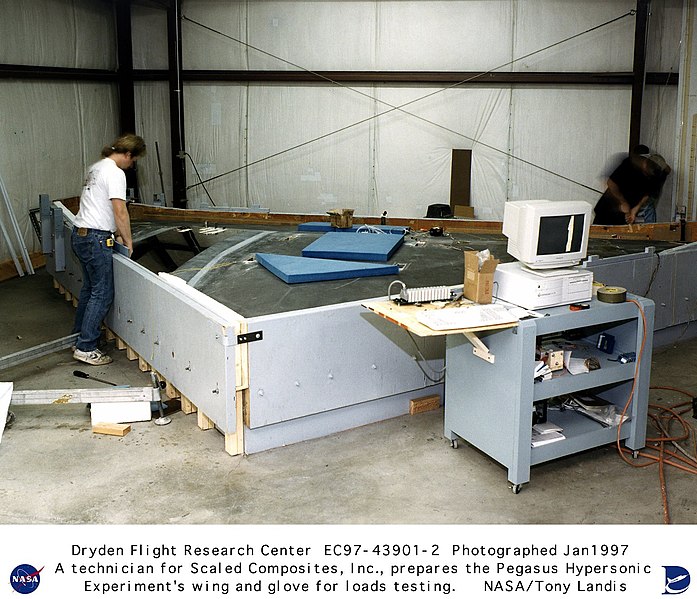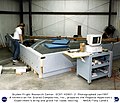File:Pegasus Rocket Wing and PHYSX Glove Being Prepared for Stress Loads Testing DVIDS694565.jpg

Original file (1,536 × 1,321 pixels, file size: 395 KB, MIME type: image/jpeg)
Captions
Captions
Summary edit
| DescriptionPegasus Rocket Wing and PHYSX Glove Being Prepared for Stress Loads Testing DVIDS694565.jpg |
English: A technician adjusts the Pegasus Hypersonic Experiment (PHYSX) Project's Pegasus rocket wing with attached PHYSX glove before a loads-test at Scaled Composites, Inc., in Mojave, California, in January 1997. For the test, technicians slowly filled water bags beneath the wing to create the pressure, or "wing-loading," required to determine whether the wing could withstand its design limit for stress. The wing sits in a wooden triangular frame which serves as the test-rig, mounted to the floor atop the waterbags. PHYSX was launched aboard a Pegasus rocket on October 22, 1998. Pegasus is an air-launched space booster produced by Orbital Sciences Corporation and Hercules Aerospace Company (initially; later, Alliant Tech Systems) to provide small satellite users with a cost-effective, flexible, and reliable method for placing payloads into low earth orbit. Pegasus has been used to launch a number of satellites and the PHYSX experiment. That experiment consisted of a smooth glove installed on the first-stage delta wing of the Pegasus. The glove was used to gather data at speeds of up to Mach 8 and at altitudes approaching 200,000 feet. The flight took place on October 22, 1998. The PHYSX experiment focused on determining where boundary-layer transition occurs on the glove and on identifying the flow mechanism causing transition over the glove. Data from this flight-research effort included temperature, heat transfer, pressure measurements, airflow, and trajectory reconstruction. Hypersonic flight-research programs are an approach to validate design methods for hypersonic vehicles (those that fly more than five times the speed of sound, or Mach 5). Dryden Flight Research Center, Edwards, California, provided overall management of the glove experiment, glove design, and buildup. Dryden also was responsible for conducting the flight tests. Langley Research Center, Hampton, Virginia, was responsible for the design of the aerodynamic glove as well as development of sensor and instrumentation systems for the glove. Other participating NASA centers included Ames Research Center, Mountain View, California; Goddard Space Flight Center, Greenbelt, Maryland; and Kennedy Space Center, Florida. Orbital Sciences Corporation, Dulles, Virginia, is the manufacturer of the Pegasus vehicle, while Vandenberg Air Force Base served as a pre-launch assembly facility for the launch that included the PHYSX experiment. NASA used data from Pegasus launches to obtain considerable data on aerodynamics. By conducting experiments in a piggyback mode on Pegasus, some critical and secondary design and development issues were addressed at hypersonic speeds. The vehicle was also used to develop hypersonic flight instrumentation and test techniques. NASA's B-52 carrier-launch vehicle was used to get the Pegasus airborne during six launches from 1990 to 1994. Thereafter, an Orbital Sciences L-1011 aircraft launched the Pegasus. The Pegasus launch vehicle itself has a 400- to 600-pound payload capacity in a 61-cubic-foot payload space at the front of the vehicle. The vehicle is capable of placing a payload into low earth orbit. This vehicle is 49 feet long and 50 inches in diameter. It has a wing span of 22 feet. (There is also a Pegasus XL vehicle that was introduced in 1994. Dryden has never launched one of these vehicles, but they have greater thrust and are 56 feet long.)
NASA Identifier: NIX-EC97-43901-2 |
| Date | Taken in January 1997 |
| Source | https://www.dvidshub.net/image/694565 |
| Author | Glenn Research Center |
| Location InfoField | WASHINGTON, DC, US |
| Posted InfoField | 10 October 2012, 13:19 |
| DVIDS ID InfoField | 694565 |
| Archive link InfoField | archive copy at the Wayback Machine |
Licensing edit
| Public domainPublic domainfalsefalse |
This image is a work of a U.S. military or Department of Defense employee, taken or made as part of that person's official duties. As a work of the U.S. federal government, the image is in the public domain in the United States.
العربية ∙ català ∙ čeština ∙ Deutsch ∙ Ελληνικά ∙ English ∙ español ∙ eesti ∙ فارسی ∙ suomi ∙ français ∙ galego ∙ हिन्दी ∙ hrvatski ∙ magyar ∙ italiano ∙ 日本語 ∙ 한국어 ∙ македонски ∙ മലയാളം ∙ Malti ∙ Nederlands ∙ polski ∙ português ∙ português do Brasil ∙ română ∙ русский ∙ sicilianu ∙ slovenčina ∙ slovenščina ∙ српски / srpski ∙ ไทย ∙ Türkçe ∙ українська ∙ Tiếng Việt ∙ 中文 ∙ 中文(简体) ∙ 中文(繁體) ∙ +/− |
 |
File history
Click on a date/time to view the file as it appeared at that time.
| Date/Time | Thumbnail | Dimensions | User | Comment | |
|---|---|---|---|---|---|
| current | 19:52, 3 May 2015 |  | 1,536 × 1,321 (395 KB) | Fæ (talk | contribs) | == {{int:filedesc}} == {{milim | description = {{en|1=A technician adjusts the Pegasus Hypersonic Experiment (PHYSX) Project's Pegasus rocket wing with attached PHYSX glove before a loads-test at Scaled Composites, Inc., in Mojave, California, in Janua... |
You cannot overwrite this file.
File usage on Commons
The following page uses this file:
Metadata
This file contains additional information such as Exif metadata which may have been added by the digital camera, scanner, or software program used to create or digitize it. If the file has been modified from its original state, some details such as the timestamp may not fully reflect those of the original file. The timestamp is only as accurate as the clock in the camera, and it may be completely wrong.
| Author | NASA, Courtesy Photo |
|---|---|
| Headline | Pegasus Rocket Wing and PHYSX Glove Being Prepared for Stress Loads Testing |
| Image title | A technician adjusts the Pegasus Hypersonic Experiment (PHYSX) Project's Pegasus rocket wing with attached PHYSX glove before a loads-test at Scaled Composites, Inc., in Mojave, California, in January 1997. For the test, technicians slowly filled water bags beneath the wing to create the pressure, or "wing-loading," required to determine whether the wing could withstand its design limit for stress. The wing sits in a wooden triangular frame which serves as the test-rig, mounted to the floor atop the waterbags. PHYSX was launched aboard a Pegasus rocket on October 22, 1998. Pegasus is an air-launched space booster produced by Orbital Sciences Corporation and Hercules Aerospace Company (initially; later, Alliant Tech Systems) to provide small satellite users with a cost-effective, flexible, and reliable method for placing payloads into low earth orbit. Pegasus has been used to launch a number of satellites and the PHYSX experiment. That experiment consisted of a smooth glove installed on the first-stage delta wing of the Pegasus. The glove was used to gather data at speeds of up to Mach 8 and at altitudes approaching 200,000 feet. The flight took place on October 22, 1998. The PHYSX experiment focused on determining where boundary-layer transition occurs on the glove and on identifying the flow mechanism causing transition over the glove. Data from this flight-research effort included temperature, heat transfer, pressure measurements, airflow, and trajectory reconstruction. Hypersonic flight-research programs are an approach to validate design methods for hypersonic vehicles (those that fly more than five times the speed of sound, or Mach 5). Dryden Flight Research Center, Edwards, California, provided overall management of the glove experiment, glove design, and buildup. Dryden also was responsible for conducting the flight tests. Langley Research Center, Hampton, Virginia, was responsible for the design of the aerodynamic glove as well as development of sensor and instrumentation systems for the glove. Other participating NASA centers included Ames Research Center, Mountain View, California; Goddard Space Flight Center, Greenbelt, Maryland; and Kennedy Space Center, Florida. Orbital Sciences Corporation, Dulles, Virginia, is the manufacturer of the Pegasus vehicle, while Vandenberg Air Force Base served as a pre-launch assembly facility for the launch that included the PHYSX experiment. NASA used data from Pegasus launches to obtain considerable data on aerodynamics. By conducting experiments in a piggyback mode on Pegasus, some critical and secondary design and development issues were addressed at hypersonic speeds. The vehicle was also used to develop hypersonic flight instrumentation and test techniques. NASA's B-52 carrier-launch vehicle was used to get the Pegasus airborne during six launches from 1990 to 1994. Thereafter, an Orbital Sciences L-1011 aircraft launched the Pegasus. The Pegasus launch vehicle itself has a 400- to 600-pound payload capacity in a 61-cubic-foot payload space at the front of the vehicle. The vehicle is capable of placing a payload into low earth orbit. This vehicle is 49 feet long and 50 inches in diameter. It has a wing span of 22 feet. (There is also a Pegasus XL vehicle that was introduced in 1994. Dryden has never launched one of these vehicles, but they have greater thrust and are 56 feet long.) NASA Identifier: NIX-EC97-43901-2 |
| City shown | Washington |
| Credit/Provider | U.S. Civilian |
| Source | Digital |
| Copyright holder | Public Domain |
| Keywords |
|
| Province or state shown | D.C. |
| Code for country shown | US |
| Country shown | US |
| Original transmission location code | NIX-EC97-43901-2 |